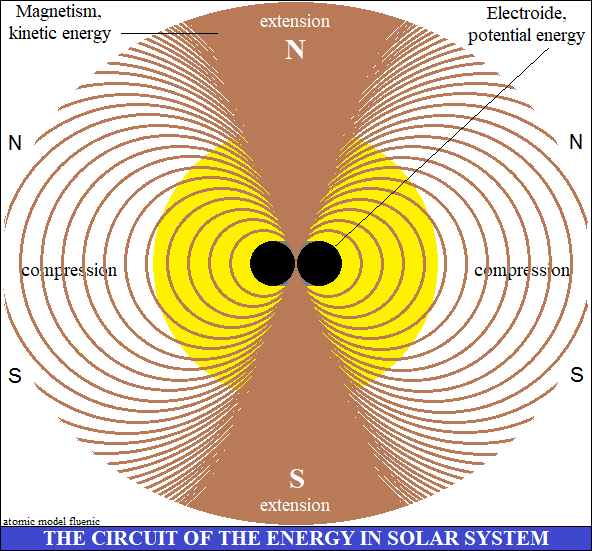The orthogonality
property of vectors
In this article, we detail the actions of the orthogonality property.
We use the names electric and magnetic, being established in culture,
but we ignore those of electric charges and electric current, being unreals.
Oersted's discovery of the magnetic field was unexpected.
Explanation:
By connecting an electric wire to the terminal of an electricity source, it
will be electrostatically polarized.
The source terminal electrostatically induced its polarities on the entire
surface of the wire (vector polarities).
By connecting another wire to the other terminal and it will be
electrostatically polarized, with the polarity of the terminal.
The two wires became the extensions of the terminals, obviously electrostatically
polarized with opposite signs.
Understanding the simple force of attraction between the two vector polarities,
electric (or magnetic),
we see the absurdity of the official conceptions about electricity, magnetism
and force.
If we put the ends of the wires in contact, the polarities attracting each
other,
they align in a closed circuit, through their attraction from close to close.
The polarities belong to the atoms and are part of their circuits, surrounded
by magnetic circuits.
Atoms, by aligning their electrical circuits, also align their magnetic circuits.
This is how the magnetic effect of electricity (not of electric current) "appears".
The magnetism around atoms, having the same orientation
forms a common magnetic field (CMF) around the wire.
Basically, by closing the circuit, the source transformed
the electrostatic polarization into electromagnetic polarization.
The unique way of orienting the electric and magnetic circuits closed orthogonally,
represents the orthogonality property of the vectors.
This property is known as the rules of the right hand, the left hand, of the
drill, etc.
The effects of vectors orthogonality:
In orthogonally closed vector circuits, the vector properties are the same
for each circuit
and do not change if we call them electric or magnetic.
In the example above, magnetic circuits act with the properties of attracting
the polarities with opposite sign, as in electrical circuits.
But also with the rejection force between parallel magnetic circuits, oriented
in the same sense.
The force of attraction is maximum when the vectors are collinear and
decreases
when they form an angle (probably due to the internal structure of the property).
Thus, the vectors are atracting linearly (on the shortest path)
and the vector circuit tightens towards the center, generating centripetal
force.
Consequently, the force of attraction between vectors in closed circuits
(electric or magnetic) is transformed into centripetal force.
The magnetic centripetal force compresses and orthogonally aligns the electrical
polarities - the voltage U.
The rejecting force is the force between the magnetic circuits,
parallels, with the vectors oriented in the same sense.
The rejecting force turns into the propagation force
of the alignment of the electrical polarities in the closed circuits.
The electrical circuit also acts through the same attraction and repellent
properties.
However, the rejection force between the parallel electrical polarities in
the circuit
have as opposiion by the magnetic centripetal force, the voltage U
(the voltage increases, increses and the density of the oriented polarities).
finding:
An electric welding machine (CD) is prepared for working:
The connecting cable, pliers and electrode are electrostatically polarized.
At the time of welding, the connecting cable "moves", tends to straighten.
It is the effect of the orientation of the EM polarities, binding more rigidly
the atoms in the structure.
However, there is a difference between the electrical circuit and the magnetic
circuit.
The electrical circuit is fixed in the structure of atoms whose polarities
are oriented.
In the common magnetic circuit (CMF), the circuit structure is purely vectorial
(field).
This detail is discussed below.
The EM force, so much used is the interaction between two closed vector circuits
(magnetic). It is a particular case of the centripetal vector force.
There are no wire-shaped and insulated metal structures in nature.
In nature, however, there is EM force, with Faraday's induction being an example.
In induction, the "variable" magnetic field orients the magnetic
field of the atoms
and, implicitly, orients in the open circuit, their electrical polarities.
The open circuit, being electromagnetically aligned, enter the interaction
of the two closed magnetic circuits, producing EM force.
The phenomena of the sun.
Cosmic bodies have their characteristic phenomena:
light; form; magnetic field; rotational and gravitational motion.
The planet we live on also has these phenomena, less light.
These phenomena must be united by something, in the entity of the cosmic body.
We begin the analysis of this idea, with the properties of the magnetic field.
As I said, the magnetic field has a purely vectorial structure.
So, the forces of attraction between the magnetic polarities in a closed circuit,
turn into a centripetal force.
The sun's magnetism coincides with the extension of the solar system, with
the "gravitational attraction".
The purely vector centripetal force propagates to the center of the sun at
the speed of light.
The gaseous substance of the sun through which the centripetal force passes
is an obstacle.
The interaction of the centripetal force with the "obstacle" electrically
polarizes the substance in two directions:
On the vertical direction (REP), which accelerates the substance angularly
and produces rotational motion.
The angular acceleration is maximum at the equator
and decreases towards the observed differential poly - rotation.
And in the horizontal direction (Faraday's induction), producing EM force,
transformed into centripetal acceleration, weight, "Newton's apple".
Centripetal acceleration increases the pressure and density of the substance.
Under these conditions, the length of the induced electrical polarities increases
with depth,
due to the increase in substance density and pressure,
becoming purely vectorial closed circuits in the electroide.
In summary, the pure vector magnetic circuit, the kinetic energy, continuously
transforms (decomposes) the gaseous substance and compresses it into the pure
vector orthogonal electric circuit of the electroide, in potential energy.
The magnetic field of the sun is one of the phenomena united in the process
of functioning of the stars.

